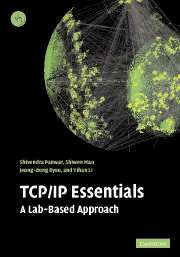Book contents
- Frontmatter
- Contents
- Preface
- Acknowledgements
- General conventions
- List of abbreviations
- 0 TCP/IP overview
- 1 Linux and TCP/IP networking
- 2 A single segment network
- 3 Bridges, LANs and the Cisco IOS
- 4 Static and dynamic routing
- 5 UDP and its applications
- 6 TCP study
- 7 Multicast and realtime service
- 8 The Web, DHCP, NTP and NAT
- 9 Network management and security
- References and further reading
- Appendix A Instructor's guide
- Appendix B Initial configuration of the routers
- Appendix C Source code
- Appendix D List of key requests for comments (RFC)
- Index
9 - Network management and security
Published online by Cambridge University Press: 05 June 2012
- Frontmatter
- Contents
- Preface
- Acknowledgements
- General conventions
- List of abbreviations
- 0 TCP/IP overview
- 1 Linux and TCP/IP networking
- 2 A single segment network
- 3 Bridges, LANs and the Cisco IOS
- 4 Static and dynamic routing
- 5 UDP and its applications
- 6 TCP study
- 7 Multicast and realtime service
- 8 The Web, DHCP, NTP and NAT
- 9 Network management and security
- References and further reading
- Appendix A Instructor's guide
- Appendix B Initial configuration of the routers
- Appendix C Source code
- Appendix D List of key requests for comments (RFC)
- Index
Summary
The Internet is an insecure place.
The MIT Kerberos TeamObjectives
SNMP and MIBs, using NET-SNMP as an example, and using NETSNMP utilities to query MIB objects.
Encryption, confidentiality, and authentication, including DES, RSA, MD5 and DSS.
Application layer security, using SSH and Kerberos as examples.
Transport layer security, including SSL and the secure Apache server.
Network layer security, IPsec and Virtual Private Networks.
Firewalls and IPTABLES.
Accounting, auditing, and intrusion detection.
Network management
The Simple Network Management Protocol
In addition to configuring network devices when they are initially deployed, network management requires the performing of many tasks to run the network efficiently and reliably. A network administrator may need to collect statistics from a device to see if it is working properly, or monitor the network traffic load on the routers to see if the load is appropriately distributed. When there is a network failure, the administrator may need to go through the information collected from the nearby devices to identify the cause. The Simple Network Management Protocol (SNMP) is an application layer protocol for exchanging management information between network devices. It is the de facto network management standard in the Internet.
Figure 9.1 illustrates a typical SNMP management scenario, consisting of an SNMP manager and multiple managed devices. A managed device, e.g., a host computer or a router, maintains a number of Management Information Bases (MIB), which record local management related information.
- Type
- Chapter
- Information
- TCP/IP EssentialsA Lab-Based Approach, pp. 187 - 213Publisher: Cambridge University PressPrint publication year: 2004



